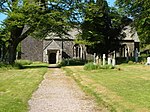Fardel Manor
Former manors in DevonGrade II* listed buildings in DevonGrade I listed houses in Devon

Fardel is a historic manor in the parish of Cornwood, in the South Hams district of Devon. It was successively the seat of the Raleigh and Hele families. The surviving Grade I listed medieval manor house is situated about half-way between Cornwood and Ivybridge, just outside the Dartmoor National Park on its south-western border.
Excerpt from the Wikipedia article Fardel Manor (License: CC BY-SA 3.0, Authors, Images).Fardel Manor
South Hams Cornwood
Geographical coordinates (GPS) Address Nearby Places Show on map
Geographical coordinates (GPS)
| Latitude | Longitude |
|---|---|
| N 50.4003 ° | E -3.9543 ° |
Address
PL21 9HR South Hams, Cornwood
England, United Kingdom
Open on Google Maps








